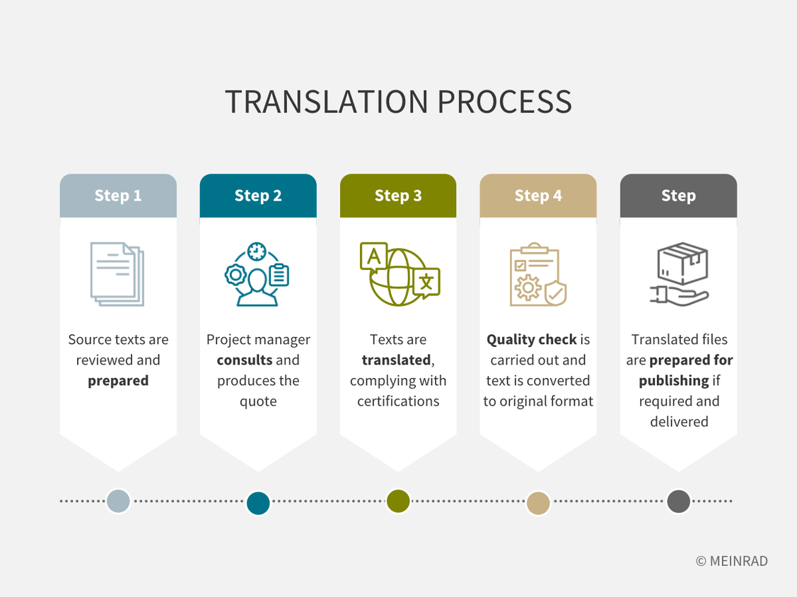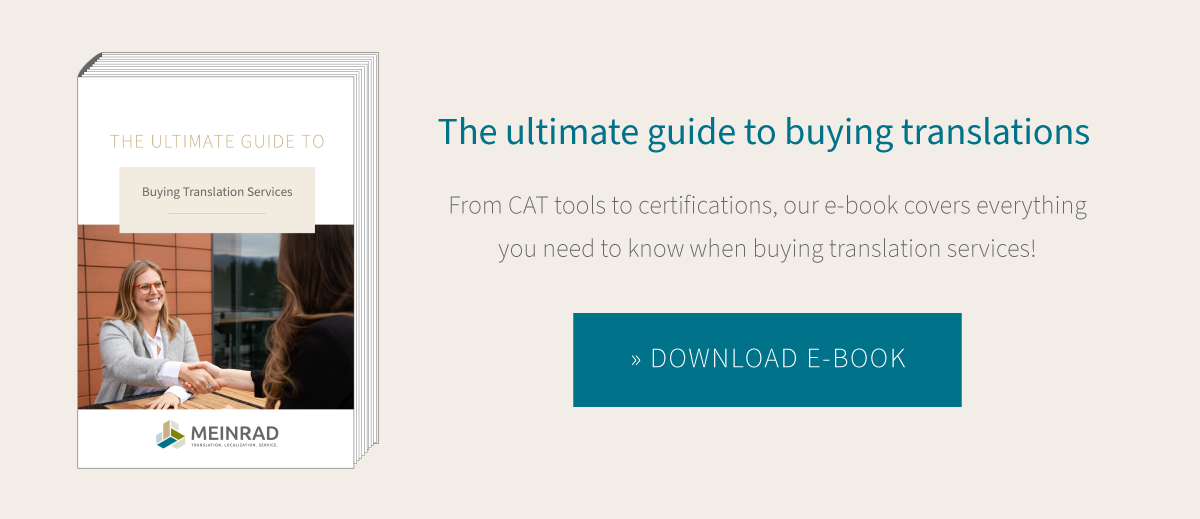
Translation is about more than just conveying a text from one language to another. At a translation agency, teams of experts work together not just to produce high-quality translations, but also to make clients’ everyday work easier. Preparing texts before and after the translation has a key role to play in a successful translation process, so if you’re aware of that process, and which parts of it can be the most time-consuming, it’s easier to understand the prices in quotes.
The translation process at a translation agency is more complex than many people think. There’s a lot more that goes into it than simply sending a text to a native speaker, who then translates it from language A to language B and sends the file back to you. Before the translator can even begin their work, the translation agency needs to prepare the project. That’s because files aren’t sent in their original formatto the – mostly freelance – translators: instead, translations are produced in a CAT tool. One benefit is that these tools store the translations, which helps save money with future projects, and another factor is the wide range of programs and file formats used in technical documentation – it would be impossible for any translator to have all the software installed on their computer to work on the various files in their original formats.
Reviewing and preparing the source files
When you ask a translation agency for a translation, the first thing they’ll do is carry out a visual review of the files. The file format and the “condition” of the files are key factors in the subsequent translation process: some files can be imported into the CAT tool without any major problems, but others may need a lot of time-consuming preparation.
For example, file formats that can’t be edited (such as PDF files) usually require more preparation as they first need to be converted into an editable format, such as Word. But converting a file doesn’t necessarily mean that it’s ready to be translated – the conversion can sometimes cause considerable problems with the layout, depending on the complexity of the graphics in the original file. Section breaks may be introduced that interrupt the flow of the text, words and even letters may be split wrongly, the contents section may not be identified correctly (so it won’t be automatically updated later on), and individual letters or numbers may not be recognized and aren’t displayed as they should be. If the file is in this “condition”, it’s simply unsuitable for translation. The only way to make it suitable is to manually prepare it for the CAT tool, and these changes can take a long time – from a few hours to several days – and create a lot of extra work for the experienced project managers at the translation agency. This extra work will usually then be added to the price you pay for the translation.
But even seemingly simple files like Word or Excel documents may need a specific filter before they can be imported into the CAT tool. And that’s where localization engineers come in.
Expert project managers
The people responsible for all of this are project managers, who are absolute experts. Project managers need to know what they’re doing in order to handle your files correctly and prepare them appropriately. It doesn’t take long for them to go through a few steps and estimate the amount of work required to deliver a project, using their many years of experience and in-depth knowledge of translation software and what it can and can’t do, file formats, the import/export options and more. All communication goes through the project manager – with you as the client, with translators and reviewers, and if needed with other people such as localization engineers, the layout team etc. – as they coordinate the whole translation process and make sure you end up getting the high-quality translation you expect. So it’s very important that the project manager goes through the details of the project with you in advance.
Establish expectations
Not all translations are created equal. There are various service and quality levels to meet different requirements, so before the project begins you should know the purpose of your document and why you need it translated. The more the agency knows about your expectations, the better.
The translation itself
This is the step where the text is translated from language A to language B, and it involves more experts. A certified translation agency (the main standards are ISO 17100, ISO 13485 and ISO 18587) will take particular care in checking that their translators have the required qualifications to deliver high-quality translations.
Processing the translated files
Once the translation is complete, the layout of the files may need to be reviewed – depending on the language, file format and structure of the original file – because text lengths can vary considerably between languages. And if the source text layout wasn’t suitable for translation, for example with small text boxes, hard returns for formatting or unhelpful use of tabs, text can end up in different places in the translated file. In many cases only minor changes will be needed, but sometimes it will take a lot longer to get the file up to scratch. If you’d rather not make these changes yourself, translation agencies can do it for you as part of their desktop publishing services.
Translation agencies do more than just translate: they handle every part of the process.
Experts are involved in every stage of a translation project, and their aim is to establish a strategic partnership with you to make your everyday work as easy as possible.
Transparency over what you’re spending
As you can see, the pre- and post-translation stages for your files are every bit as important as the translation itself. This work can be extremely time-consuming, but it needs to be done, and it’s reflected in what you pay for translation services. So communication should be transparent to make sure everyone is aware of all the steps involved in producing the translation – only then can you effectively compare prices and quotes from different agencies.
Main image: © MEINRAD


